On Sept. 19, Twitter user haniwa (@ayyk92) posted a fan comic whose conclusion focused on a blonde woman with horns, a visual mix of official characters Princess Peach and Bowser from Nintendo’s Super Mario franchise. This fan creation would be nicknamed Bowsette.
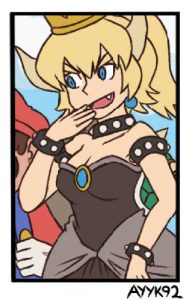
The original Bowsette fan design by haniwa (@ayyk92).
The fan comic has now garnered over 80 thousand retweets and motivated many to post their own spin-off art. Sept. 19 could be seen as essentially Bowsette’s birthday, and as with any fan work, it started with the source material.
Bowsette’s Backstory
A new trailer about the upcoming Nintendo Switch title New Super Mario Bros. U Deluxe was released, showcasing the Super Crown. With this new item, playable character Toadette can turn into Peachette, and as that name suggests, Peachette is what happens when you fuse Toadette with Peach into what amounts to a Princess Peach look-alike. (The magical transformation also grants new abilities like gliding, but the most dramatic change is still the shapeshifting—though Twitter user Ian C Samson drew a funny Bowsette comic focusing on the gliding power.)
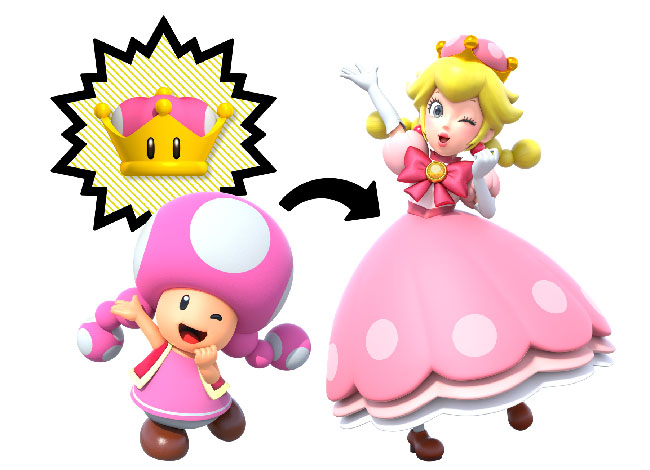
This new development inspired Twitter user haniwa to explore a speculative scenario where Bowser uses the Super Crown and turns into a mash-up of Princess Peach and himself. This fusion is now popularly called Bowsette. (Though as others have pointed out, the naming convention doesn’t entirely make sense—but it does still have a nice ring to it. Twitter user whalewithay has drawn a concept that is more literal about the Bowsette name, depicting a fusion of Bowser and Toadette.)
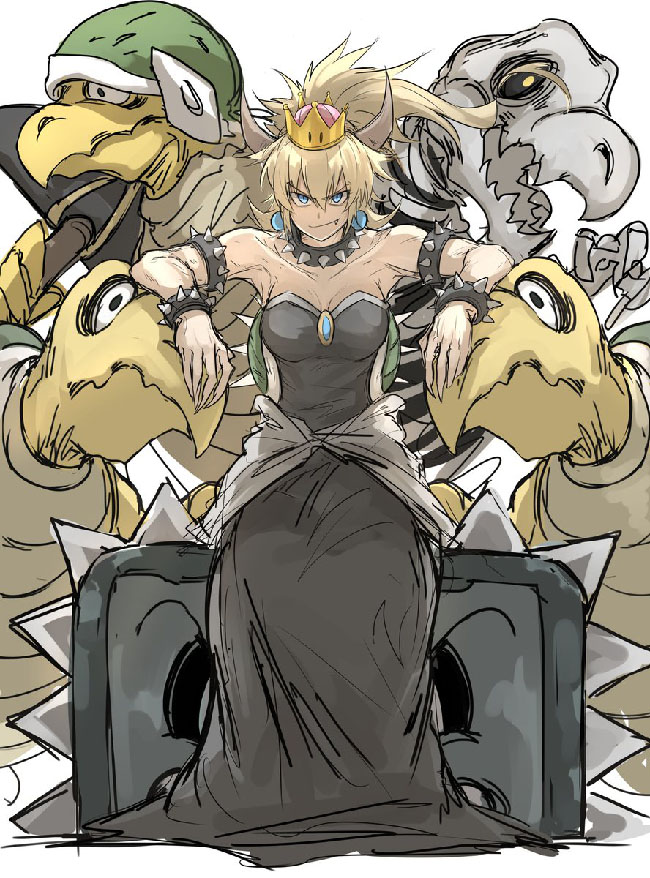
A particularly commanding Bowsette by Twitter user kankan33333.
Bowsette has inspired a creative frenzy online, prompting many people to post their own art of the concept, ranging from those that stick close to the original fan comic’s design, to those that contribute new versions of the Bowser-Peach fusion. Artist and Nintendo Brand Ambassador GandaKris has even crafted a custom Amiibo figure of Bowsette. There’s Bowsette cosplay, and Bowsette balloon art.
And there’s been a lot of smut too.
Playing with Archetypes
Other than subsets of the Internet giving the concept a sexual makeover that ranges from typically exaggerated breasts to far more explicit material, there’s just something about Bowsette. Potential beyond severe objectification and voyeurism.
(And even part of the explicitly sexual remixes of Bowsette could say something about the rush to sexualize, and about certain subsets of the audience. And likely not all of it is entirely negative; there’s sex-positive, but then there’s also crossing the line into something more exploitative. There is also the possibility of excessive smut, which could potentially limit a balance and variety with other genres and ideas.)
While some might see something to objectify with Bowsette, there can be more to the concept. For example, Bowsette can touch upon a fusion of the classic dragon and princess archetypes based on the associated ideas surrounding the visuals and history of Bowser and Peach. Bowser is very much obviously the dragon; Peach is literally a princess.
Bowsette can suggest the idea that the princess doesn’t want to be rescued by the knight or prince, she wants to be the dragon in power. That idea is not entirely taking the full context of Bowser and Peach into consideration, but it is saying something about the iconic imagery and fairy tale history they do invoke.
Even when thinking more about Bowser and Peach’s specific history and applying it to Bowsette, other interesting observations can be made.
For example, after all this time of Bowser pursuing Peach, he’s essentially become her when looking at the fan design. (There is a piece by Twitter user GraphicGinger that shows the full reverse, with Peach becoming Bowser-like.)
If Bowser at least partially chases Peach around in the interest of gaining power over her kingdom by way of marriage, then just straight up embodying her cuts straight to the point. This possibility of shifting power attached to changing gender (and species) can add another layer to the whole concept of Bowsette.
A Magical Power-Up for Gender Fluidity
Speaking of shifting and changing, there’s the explicit transformation Bowser undergoes when he becomes a princess. There’s nothing that subtle about this. Magical means literally enable Bowser to become female. (The visuals that draw from the physical similarities with Princess Peach make this clear.) The concept of Bowsette can be gender fluidity made obvious through the fantastic.
While there may be some negative reactions to this, there have also been reactions that simply accept this and celebrate it. And there have been a lot of fantastical metaphors in pop culture, like Buffy the Vampire Slayer and its literal “high school is hell” theme most prevalent in the early seasons. It’s nice to see more fantastical—even whimsical—metaphors for gender fluidity as well, and the Bowsette concept feels like it can be one of those metaphors, and a positive one too.
The original Bowsette comic itself is pretty innocuous comedy; none of the characters have an intensely negative reaction to what’s going on—Peach and Luigi are just more stunned by what is a big surprise to them, Mario and Bowser-later-Bowsette are just accepting and matter-of-fact about it all. Even Bowsette actually isn’t overtly sexualized to a huge extent; there are no explicit situations, and there are no exaggerated body proportions.
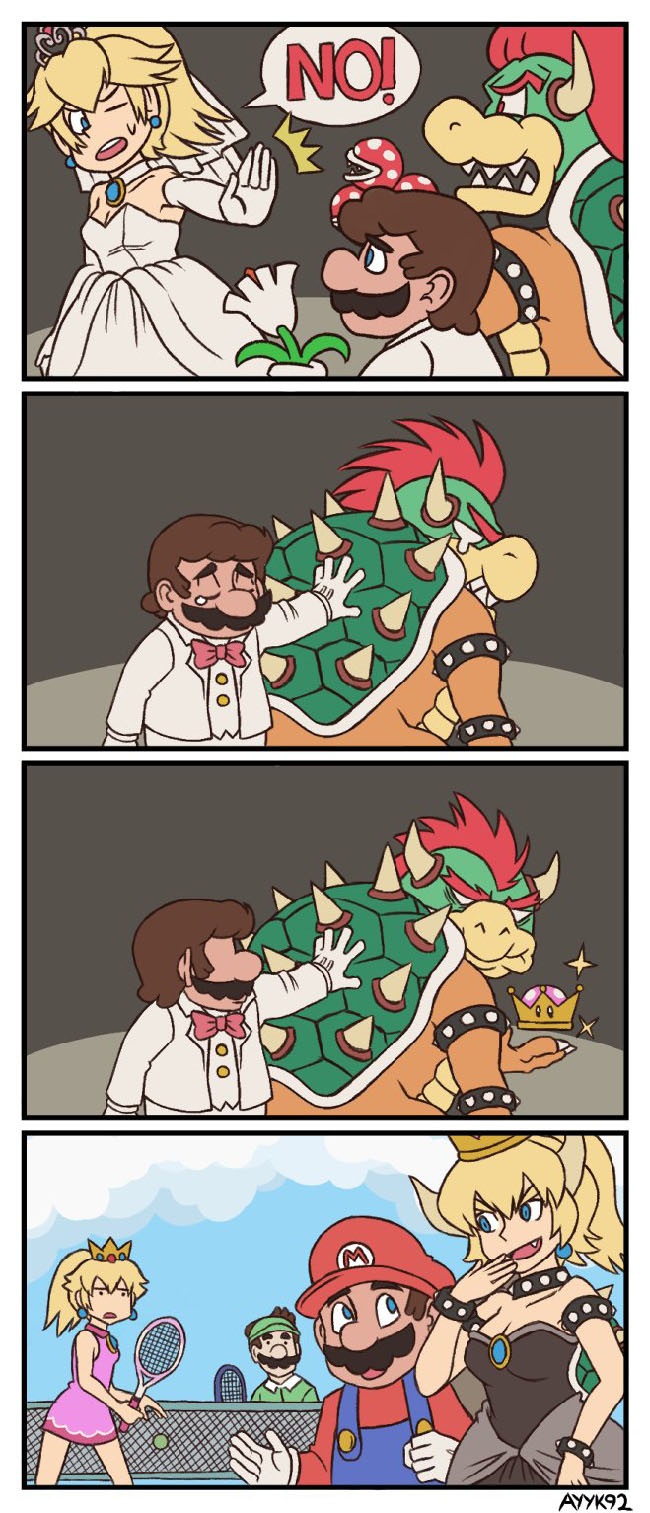
The original fan comic by haniwa (@ayyk92).
Diversified Courtship
The gender fluidity made fantastic can add a new LGBTQ+ layer to Bowser’s relationships, like with Princess Peach. Bowser and Peach have some sort of dynamic that is definitely canon, though it’s no actual romance. They can have a dynamic just from their role as adversaries, and from all the times Bowser has tried to marry Peach (as observed in this video by Thane Gaming). Subsets of fandom have spun off from that canon into alternate visions of the two, creating a following for appreciating or shipping Bowser and Peach as a speculative couple—and there has been art that maintains that pairing while incorporating Bowsette into it, giving the pair an LGBTQ+ remix.
While there are fan works shipping Peach with the original Bowsette design that deeply mirrors the former, there are other depictions of Peach with alternate Bowsette designs, making the latter look more distinct and adding even more variety overall.
Picture the slim white blonde princess with the tall, dark, muscular princess. Or with the more monstrous-looking princess. Or a mix of both.
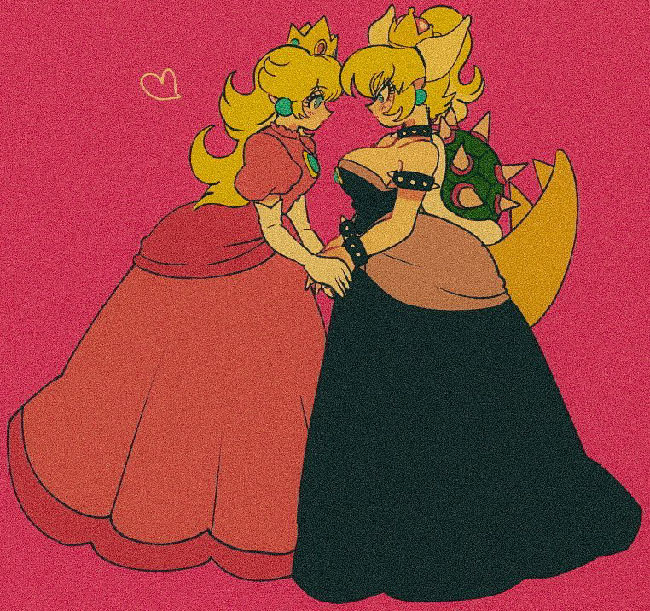
Peach and Bowsette mirror each other in terms of looks and attraction in this piece by Tumblr user pikurusu00.
Variety in Women’s Bodies
There’s just this collective creativity surrounding Bowsette on the Internet right now. As mentioned above, there are other people’s tweaks to the original fan design that try to make Bowsette less of a mixed clone of Peach and more representative of Bowser himself—the darker skin reflecting more on his scale color, the fiery red hair that’s maintained, the muscles honoring his status as a bruiser. That alone points to Bowsette ending up as another vehicle for the discussion on more varied body types and colors in depicting women, and just reflecting the real-life diversity of women’s appearances.
Make the image of women as muscular and dark more prevalent. It doesn’t always have to be the slim white blonde.
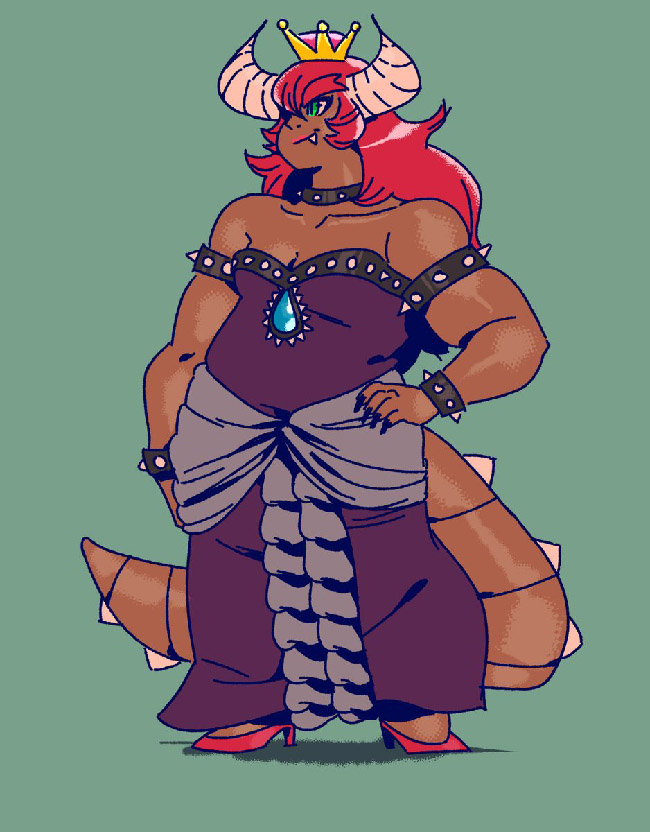
An alternate design of Bowsette by Twitter user HedgeMom.
Bowser has become an iconic character, and that has helped make him a useful vehicle for this visual exploration into more diverse-looking women. And it feels like Bowsette can largely avoid getting associated with what seems like the unfortunate tendency to often make villains dark-skinned. (And yet villains can enjoy great popularity, like Ganon from The Legend of Zelda series.) Bowser may be an antagonist, but he does not feel like a truly morally reprehensible villain. How many times has he been turned playable or an ally for Mario and company? He’s a veteran fighter from the Super Smash Bros. series and there’s a reason “Go-Karting with Bowser” is a trope online. Bowser—and by extension Bowsette—feels more like a rival or harmless antagonist. And an antagonist is someone who opposes the protagonist, but isn’t always a villain.
Let Her Be Monstrous
Others have made a design tweak that embodies Bowser even more, preserving the reptilian head. And this brings up another thing to consider. While there is a certain aesthetic appeal to the monster girl design trope that is mostly humanoid with only some monstrous features on the fringes—which the original Bowsette design likely falls under—it also feels like it gets a little overdone, and misses out on other design possibilities.
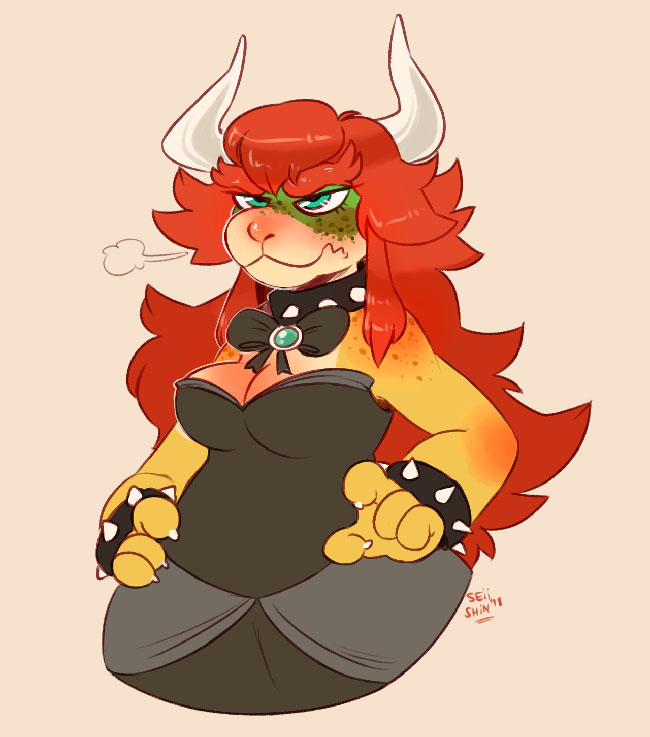
A more monstrous-looking Bowsette by Tumbler user seiishindraws.
It’s not just about growing a little tired of a particular visual trope. There’s a subtle undercurrent of gender-based double standards, when considering trends in depicting monster men.
It’s a struggle to think of monster women that get to look as monstrous as their male peers often are. It feels like there’s a higher incidence of monster men getting to look more monstrous than monster women, who often look more humanoid. (Granted, there’s frankly more monster men than monster women.)
It’s like sexual dimorphism taken to the extreme in fantasy settings. Even Wired pointed out that a previous iteration of World of Warcraft had initial designs of more monstrous-looking nonhuman women, but they were changed to something more conventionally attractive due to fan complaints about them being too “ugly” (the same complaint was not made about the nonhuman men).
It feels like monster men’s nonhuman features can be pushed, they can look fierce and powerful and interestingly distinct from humans. But the minute it’s a monstrous woman, she can’t be too monstrous—she still has to look traditionally humanoid, traditionally attractive in her appearance, still approachable. How this approachability is defined could be viewed more from the male perspective.
On Syfy Wire, freelance comics editor Alison O’Toole talked about the few roles female characters generally get to play in monster stories, and the restrictions they still face even when they play the actual monster. “Even if they get to be monsters, they’re usually sexualized for a straight male gaze,” said O’Toole. “Non-binary monsters fare even worse.”
The issue could even be compared to recent controversy over some people saying Captain Marvel should smile more, a criticism that’s rarely been applied to her fellow male heroes, i.e. Iron Man, Captain America, and Doctor Strange. Part of it feels like always keeping the woman traditionally attractive, nice, and approachable, even if she’s a superhero, even if the same isn’t asked of other superheroes who are men. Or even if she was a monster.
This seems to be a prevailing thought: monster women should generally look conventionally nice, they should look more human and approachable still, even if they are monsters. They’re women first, monsters second. You can go crazy with designing monster men, but not monster women.
And what of the classic Beauty and the Beast story? Even if the cursed prince turns back into a human in the end, he largely remains as monstrous-looking as possible when Beauty grows to love him; this happens across a wide selection of different retellings. How often is the exact reverse done, where the princess gets to be monstrous, and the uncursed fully human man grows to love her?
Interestingly, before Twitter user haniwa posted the original Bowsette fan comic, Rafa Knight on ArtStation made a Princess Koopa 3D computer-generated sculpture based on a drawing by Twitter user Guoh, and they all focus on what resembles a more nonhuman-oriented design of a Peach and Bowser hybrid.
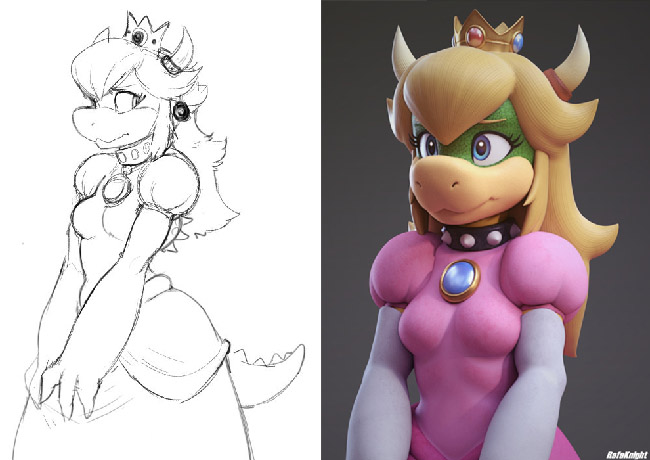
The original black-and-white sketch was drawn by Twitter user Guoh in June 2017, while the CG sculpture based on it was made by Rafa Knight and posted to Twitter in July 2018, as well as on ArtStation.
Then again, people could make the point that a more humanoid non-white Bowsette design is still preferable. And other people could say there can be more nuance to monster characters; that while having dark monsters often as villains could be counterproductive, monsters can also be interesting characters themselves—they can even be sympathetic protagonists—and if monster men get to be monstrous, monster women should be allowed to do the same.
But it doesn’t have to be a matter of one or the other in this specific context of sharing fan creativity online. Under the circumstances, both ideas can coexist. Many ideas can coexist together. A vibrant variety of ideas is more desirable than material that ends up looking like too much of the same thing.
Influencing and Crossing Over
This concept is growing even beyond Bowser. As the original Bowsette comic was about wondering what would happen if Bowser wore the magically transformative crown, others have asked the same question—but not about Bowser alone. What if other characters from the Super Mario games held the Super Crown? There’s Birdo wearing the crown as drawn by Tumblr user destinytomoon. Michael Lee Lunsford, creator of the web comic Speak of the Devil, imagines what would happen if Boo used the Super Crown. There’s Bullet Bill in possession of the crown as drawn by Owlboy creator Simon S. Andersen. (Here’s a fun Nintendo crossover—Twitter user BeanieBomber shows how Blooper wears the Super Crown and becomes Pearl from Splatoon 2.)
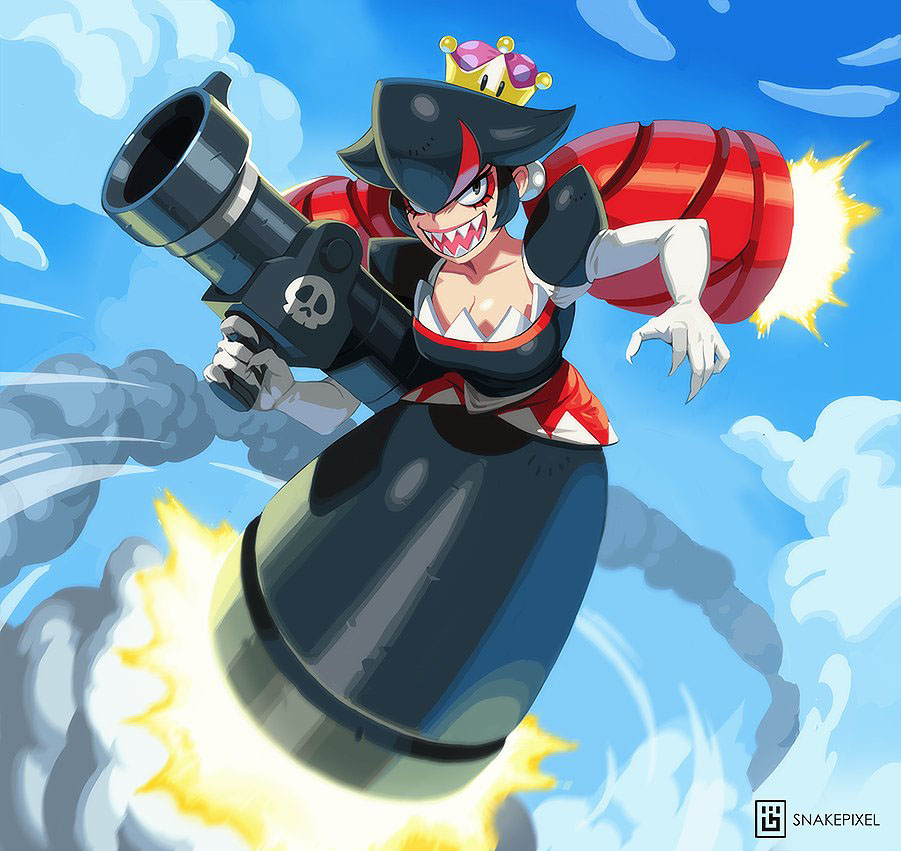
Owlboy creator Simon S. Andersen draws Bullet Bill getting the Super Crown, and calls the resulting fusion Bullette.
The concept has even crossed into different fandoms and different media. What if Officer Patrick Dooley from The Darkside Detective had the Super Crown? What if Broly from extended Dragon Ball Z material had it? (Admittedly this one is more of an interesting commentary on developing canon with Broly and Dragon Ball Super character Kale, rather than making any new piece of art.)
Bowsette has become one of those concepts that can inspire a lot of people to just make things, to make art, and share it; and it can inspire commentary on a variety of topics and ideas.
A Full Circle?
To top it all off is the indication that Nintendo almost did add something like Bowsette to an official game. Forbes reports that Japan’s newly released book, The Art of Super Mario Odyssey, shows deleted material that was about Bowser using his own version of Cappy to control Peach. Forbes includes a photo of that cut concept from the book. (There is already fan art of the scrapped design.)
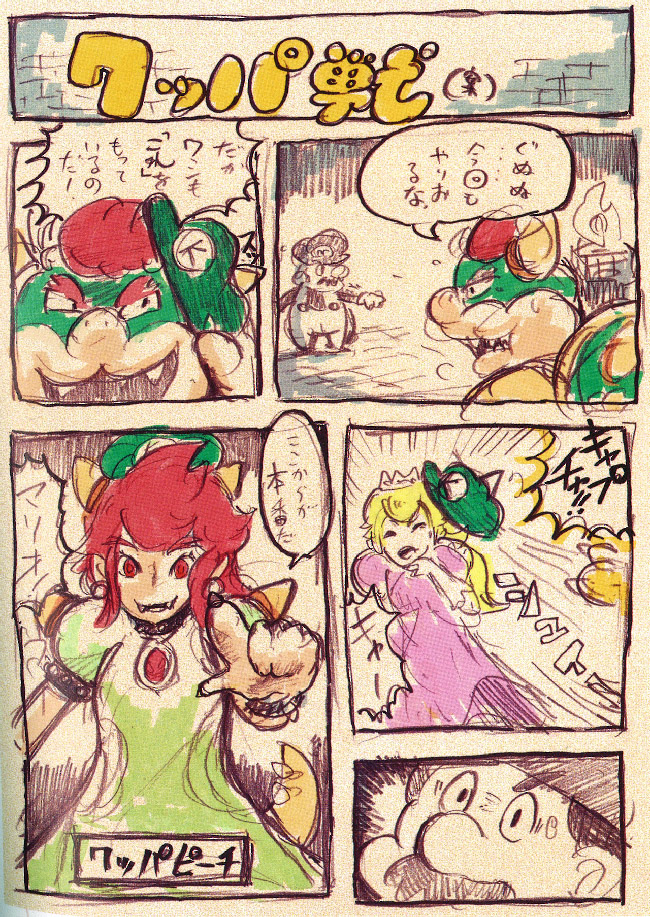
Note how the book’s concept art, found on page 355, keeps Bowser’s red hair, along with the tail and other features.
Almost official or not, the concept of Bowsette opens up a lot of food for thought:
- More body diversity for women in all sorts of visual art.
- Let monster women be given the chance to be as monstrous-looking as monster men.
- Skip political marriage and take the throne by literally becoming the Queen.
- Use fantastical props to symbolize gender fluidity.
Approaching Bowsette with an open mind reveals the concept can have a lot to offer, with potential as a vehicle for various forms of creativity and analysis.
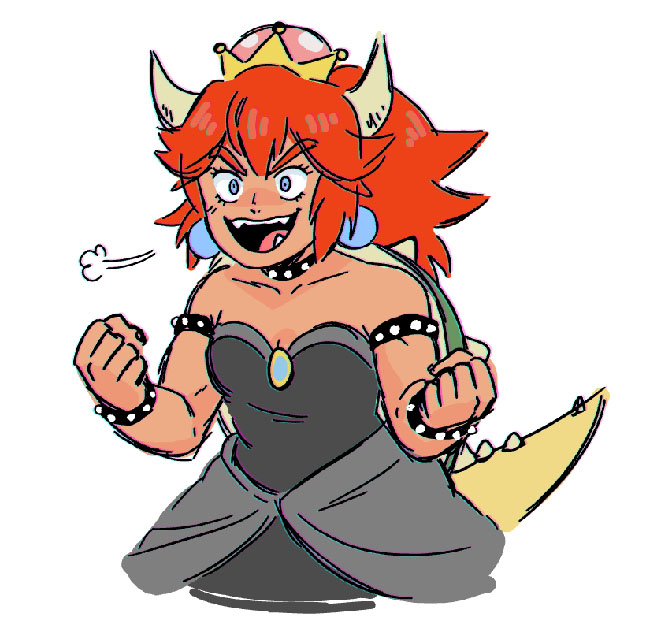
A triumphant-looking Bowsette by Kiana Khansmith, a Storyboard Artist working at Disney Television Animation.
Latest posts by Alyssa Wejebe (see all)
- From Fan Art to Film Crew: RJ Palmer Talks Detective Pikachu - September 4, 2019
- Women in Gaming: Borderlands 3 Mission Designer Kate Pitstick - August 20, 2019
- Equipping Your Emotions in Crystar - August 14, 2019
